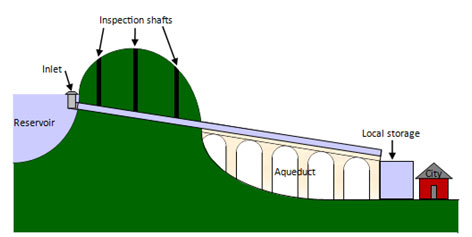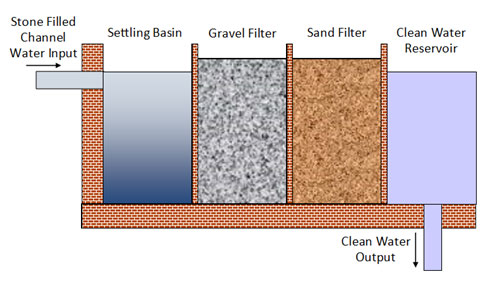How Can Water Systems Be Harmful To Civilizations
The Aboriginal World, equally Illustrated past Rome
Water management and water handling are equally old as civilisation itself. In fact, civilization is incommunicable without a proper water supply. We know much virtually ancient aqueduct and irrigation applied science through archeological digs. From Mesopotamia and Aboriginal Egypt to the Indian subcontinent, from the Chinese and Khmer Empires to those of the Mayas, Aztecs, and Incas in the Americas have come testify of spectacular waterworks. On a smaller, domestic scale, the Greeks and Egyptians knew how to purify water by boiling or filtering information technology through porous clay jars, just this was not a general practice. The Egyptians as well knew how to employ alum (potassium aluminum sulfate) to coagulate material out of cloudy h2o to speed its settlement and facilitate its filtration. It is the offset chemical water treatment known.
But the master engineers of the ancient world were the Romans, and it is their water systems that nosotros sympathise all-time. Our knowledge comes not simply from many well-preserved systems that tin exist found throughout what was their vast empire, only too from written works that have survived. Amid these are books by the architect Vitruvius; past the naturalist Pliny the Elder; and, especially, by the general, governor, and consul Frontinus. He had been Commissioner of the aqueducts (curator aquarum) and wrote a famous report for the Emperor Trajan on Rome'due south h2o supply, De Aqueductibus Urbis Romae. These descriptions of their circuitous water systems inform u.s.a. not only about the methods and materials they adult and used and so spectacularly (especially hydraulic physical), but also reflect the challenges that the Romans faced (as other civilizations did) because of their limited ways of water handling.
The Romans certainly knew about various qualities of water. Some of the rivers, streams, and springs that they tapped and diverted to their cities were excellent sources, others not and so much. A few of their aqueducts brought in h2o that they would not fifty-fifty beverage, but which they used for other purposes — cleaning, bathing, and even filling up pools in the arenas to hold mock naval battles! They had a practical understanding of the problems deriving from h2o cloudiness (or turbidity) and water hardness, both of which tin can lead to blockages of aqueducts. Suspended particles, which cause turbidity, can settle and silt upward the system, whereas dissolved calcium and magnesium, which cause water hardness, can atomic number 82 to incrustations and narrowing of the channels. To solve the first trouble, the Romans built huge settling pools at the head of the aqueducts. These had sloped floors to facilitate the removal of the sludge that accumulated.
The problem of water hardness could not be solved every bit easily and no doubt led to a design that allowed for the cleaning of the calibration off the walls of the conduits by hand, surely an arduous job devolved to slaves. This meant that aqueducts had to have channels or ducts that were large enough to be accessed by line-inspectors (in Latin, chosen circuitores) and workers. They likewise needed periodic vertical access shafts (lumina, columnaria) as, contrary to the popular notion of Roman aqueducts as spectacular biconvex structures spanning valleys, they, in fact, consisted for the almost part of tunnels. The access shafts as well served as air vents, as the Romans believed, quite rightly, that exposure to air improved water quality. Throughout most of these systems, h2o flowed by gravity and information technology is a wonder that they achieved regular slopes with their basic measuring tools, the chorobates, for leveling gradients, and the groma, for alignment.

Ancient Roman channel technology included settling ponds, channels or ducts large plenty for inspection, and vertical admission shafts that allowed air ventilation. Most of the aqueduct systems used gravity flow, and tunnels, rather than arched structures, were more commonly used for spanning valleys.
The Romans were aware of the principles of siphons, and a few such systems have been establish. A siphon is a much cheaper alternative than an arched structure for crossing a valley, but, as it cannot have open vents, it cannot be easily accessed for cleaning calibration. It may well be the reason for their rarity.

Although the Romans were familiar with the concept and attributes of siphons, these structures were rarely establish implemented, possibly considering they do not allow for open air venting or easy admission for calibration removal.
All in all, the administration and maintenance of the Roman h2o supply needed to be highly organized, with specialized officials, engineers/architects, laborers, and slaves assigned to each of import task.
Scaling must besides have been a serious problem in the many luxurious public baths of Rome, as large amounts of water were heated. This would have caused calcium carbonate to precipitate out of solution. Less is known nearly how this problem was addressed, but we can imagine that the heating vessels and conduits required routine descaling.
Finally, and surprisingly, in that location was one very positive effect of hard water in Roman cities. In one case water reached the h2o-castles (castellae) of the metropolis, the distribution occurred through clay so lead pipes. This once led to a generalized conventionalities among historians that atomic number 82 poisoning of the elite caused the fall of Rome. Still, there is at present scientific evidence that scaling within of the pb pipes would have prevented leaching of the toxic metal into the water.
European Stagnation and Rapid Advance After the Industrial Revolution
Non much progress occurred in Europe for a chiliad years later the fall of Rome. About cities had poor waterworks, both regarding the water supply and the disposal of sewage. This led to frequent epidemics of waterborne diseases such as typhoid and cholera, simply considering the "miasma" or foul air theory of disease propagation held sway, no measures were taken to improve the water quality. Fifty-fifty the invention of the microscope and the observations past Leuwenhoek of teeming microorganism life in water did not goad authorities to act.
The little progress that occurred was often driven past such industries as textile manufacturing and, afterwards, papermaking. Large amounts of clean water were needed for these and other processes. Alum, mentioned to a higher place, was very much in demand, not as a coagulant, only as a mordant, a substance that fixes dyes on fabrics and makes them brighter.
The industrial revolution accelerated the need for clean h2o. In 1804, large-calibration filtration using sand was invented by a Scottish engineer, John Gibb, who needed clean water for his bleaching constitute. He sold the surplus water to the public. Inside a few decades, his filtration process had been improved and was beingness applied to London's water supply. It is nonetheless widely used today. In parallel to the development of new technologies such as improved pumps and piping, big waterworks were built to bring fresh water into major cities and move sewage out — for example, the Ourcq canal in Paris, commissioned by Napoleon and built by the engineer Pierre-Simon Girard, and London's slap-up sewer system, commissioned by the Metropolitan Lath of Works and built by the engineer Joseph William Bazalgette.

The first recognized big-calibration water filtration system was invented in 1804 by John Gibb, a Scottish engineer. The organization used a series of earth material filters to purify water supplying a bleaching plant in Paisley, Scotland. In this system, h2o passed from a stone-filled aqueduct into a settling basin then moved successively through a gravel filter and a sand filter prior to inbound a central h2o storage basin. Surplus water was sold to the public.
How Can Water Systems Be Harmful To Civilizations,
Source: https://www.awt.org/resources/seed-program/water-careers/water-treatment-in-history/
Posted by: kingrepasustem.blogspot.com


0 Response to "How Can Water Systems Be Harmful To Civilizations"
Post a Comment